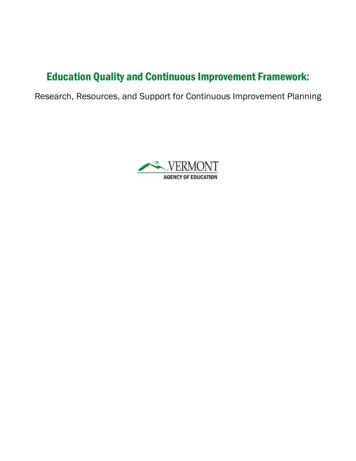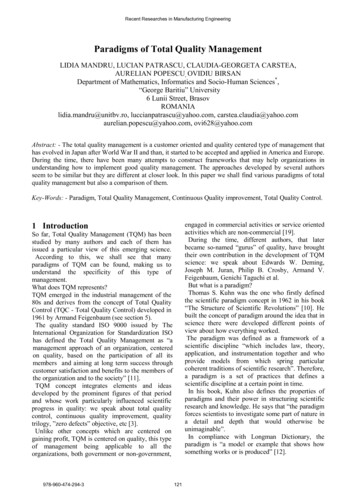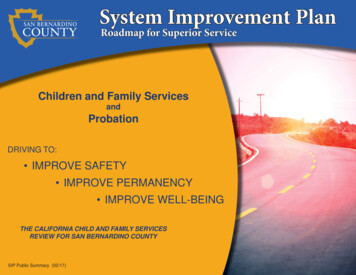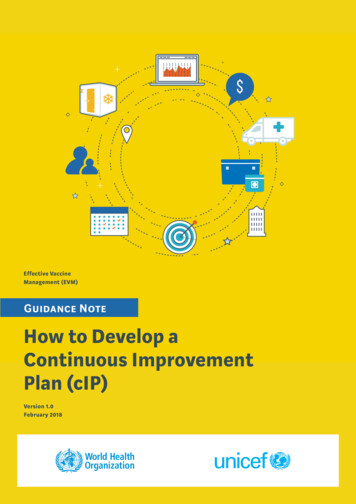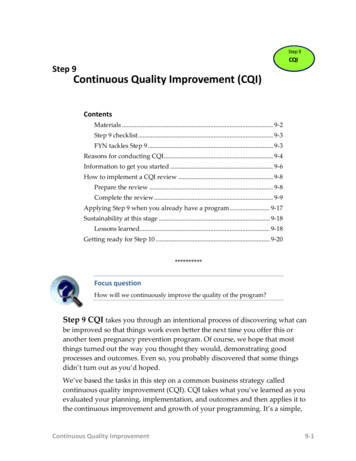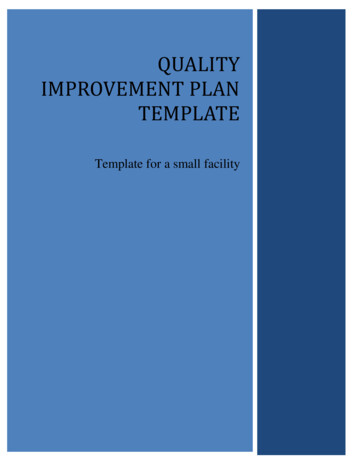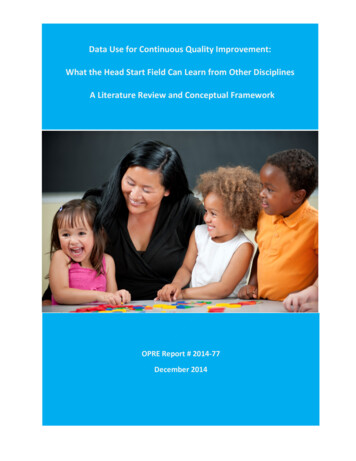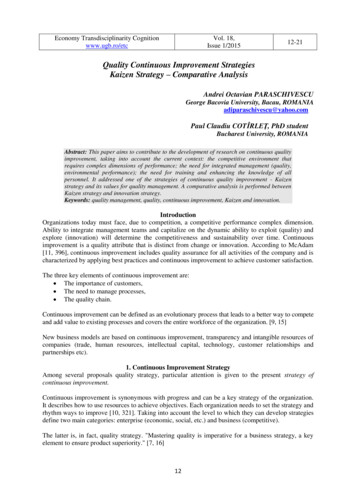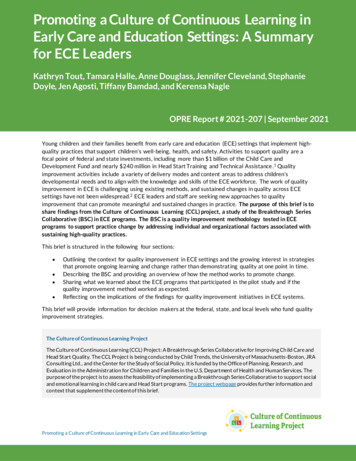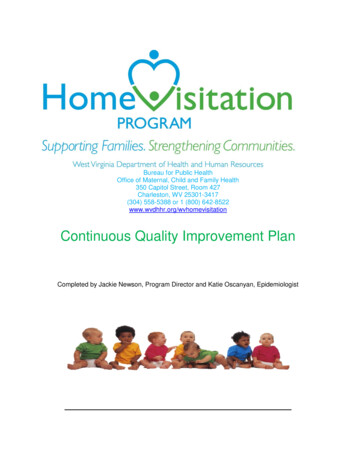
Transcription
Bureau for Public HealthOffice of Maternal, Child and Family Health350 Capitol Street, Room 427Charleston, WV 25301-3417(304) 558-5388 or 1 (800) 642-8522www.wvdhhr.org/wvhomevisitationContinuous Quality Improvement PlanCompleted by Jackie Newson, Program Director and Katie Oscanyan, Epidemiologist
Table of ContentsIntroduction1CQI Teams:2Purpose of your CQI Teams2Frequency of team meetings2Involved in the CQI process2Roles and responsibilities of State CQI Members3Roles and responsibilities of Local CQI Members3Culture of Quality4Data Collection/Data Systems6Reports6CQI Methodology7Communication9Process Map(s)10WVHVP CQI Process Map11PDSA Directions and Examples13
The West Virginia Continuous Quality Improvement (WVCQI) Plan will serve as an integralelement reflecting the commitment of the West Virginia Home Visitation Program (WVHVP) tocontinuously improve the quality of its Maternal, Infant and Early Childhood Home Visiting(MIECHV) grantees. The WVCQI Plan incorporates three key actions to build a culture ofquality. The following actions will be followed: Data will be shared with everyone from the state level to the home visitor level; shareddata will assist with the goal of building a culture of quality with all WVHVP activities.Data shared will be meaningful and reflective of the work home visitors are doing withfamilies served and also embedded in federally mandated benchmarks.Shared data will be transparent in that it will show both areas to celebrate and reflect onresolutions to identified changes. The purpose of every tier of the WVCQI Plan is toboth celebrate victories and recognize challenges.A culture of quality that ensures everyone is involved in the effort. The WVCQI Planprovides the means in which home visitors can receive important data on a regular basis.WVHVP Stakeholders will determine areas of improvement while the local level will becharged with creating solutions. West Virginia will strive to ensure each level of CQIefforts include attitude, transparency, data and commitment. Each of the efforts isdescribed in detail in the Culture of Quality section. For example, if a targeted CQI effortis around increasing breastfeeding rates, both the state and local CQI Teams would go inwith a positive attitude, a goal for achieved outcomes, a willingness to have candidconversation around efforts, ensure data drive decisions are made and a strongcommitment to making the changes outlined. Initially this will be a top down approachuntil WVCQI Local teams are comfortable with the process and then provide WVCQILocal teams the opportunity to explore CQI topics based upon data driven decisions.WVHVP will continuously strive to ensure high quality services provided to families along withoversight of evidence-based, funded home visitation programs in a safe, effective, familycentered, strength-based and equitable fashion. Program efforts may change based upon datadriven decision making, the following will always be adhered: Evidence-based, effective practices (been proven through research and valid for targetedaudience);Appropriate services unique to community needs;Innovative practices to meet identified challenges;Model fidelity (operating within the program requirements) monitored on an ongoingbasis; andHome visitors and program staff empowered to seek information through ongoingfeedback processes.WVDHHR/BPH/OMCFH/WVHVP 6/4/20141
CQI Team(s):Purpose of your CQI teamsThe key to success of the continuous quality improvement process is leadership. A WVCQI StateTeam has been established. The WVCQI State Team will provide ongoing operational leadership ofCQI activities. The WVCQI State Team will be challenged to guide the state and local organizationsto a point where people feel comfortable receiving data, sharing data, using data and seeing it assomething that is important and key to their work rather than something that is punitive and designedto identify who is not doing their job well. The intent of the WVCQI State Team is to be the guidingforce for facilitating program level CQI efforts. Due to the large quantity of data collected forfederally mandated benchmarks, along with model and funder required data reports, the WVCQIState Team will select key variables to follow closely so local WVCQI Local teams will not beoverwhelmed by data quantity. The WVCQI State Team will examine all benchmark data asreported by the Epidemiologist. Using the pre-determined targets set forth by the MCH Title V BlockGrant, Healthy People 2020 and PRAMS indicators, any benchmark that is marked as an area ofimprovement will be presented to the WV Stakeholders Group. Using a voting process, thestakeholders will determine which area to focus on for the current CQI session.The CQI Local teams will be charged with creating solutions to address areas where improvement isneeded, as determined by the WVCQI State team. The local level teams will determine possiblesolutions based on their community, program structure, model and caseload. Local teams will beresponsible for planning, testing and reviewing possible solutions.Frequency of team meetingsThe WVCQI State team will meet quarterly or more frequently as needed. In addition, eachWVCQI Local team will meet formally on a monthly basis to review information provided. It isthe expectation that CQI Local teams will have weekly “check-in” meetings (either face to faceor conference call) to discuss progress on current Plan, Do, Study and Act (PDSA) cycles.Updated reports on the status of their PDSA cycles will be submitted to the WVCQI State Teamwithin two weeks of the monthly meeting. Meetings may vary based upon the nature of theproject and the urgency for more frequent meetings.Involved in the CQI processThe WVCQI State Team will consist of the following: WVHVP Program Director, Jackie Newson WVHVP Epidemiologist, Katie Oscanyan Healthy Families America (HFA) Program Coordinator, Michelle Comer Maternal, Infant and Health Outreach Worker (MIHOW) Program Coordinator, DebbieWithrow Parents as Teachers (PAT) Program Coordinator, Tina Faber Right From the Start (RFTS) Program Coordinator, Terra Hoff Early Head Start (EHS) Program Coordinator, Traci Dalton To Eliminate Abuse and Maltreatment (TEAM) for WV Children representatives, JimMcKay and Laurie McKeownWVDHHR/BPH/OMCFH/WVHVP 6/4/20142
WVHVP identifies a stakeholder as anyone who is affected by, or can influence, a program ororganizational decision or action. Both at the state and local level stakeholder groups will beinvolved in providing input through focus groups, surveys and feedback on reportsRoles and responsibilities of State CQI membersThe responsibilities of the WVCQI State Team will include: Establish measurable objectives using federally mandated benchmarks; Update the CQI plan as needed; Identify indicators of quality on a priority basis (starting small, focused on individualtopics); and Review data snapshots and share with local CQI teams, which summarize performanceon the key indicators associated with processes and outcomes.Roles of the WVCQI State Team will include at a minimum: CQI champion – oversees the CQI Team and facilitate meetings and events. Scribe – captures all documentation/communicate to state/local team. Report onparticipant satisfaction, CQI steps and activities and outcomes using the CQI ProgressReport (Attached). Technical experts – subject matter experts (domestic violence advocate, mental healthconsultants, etc).The WVCQI State Team will provide leadership for the CQI process through support and guidedimplementation of CQI activities. Both the state and local CQI Teams will review, evaluate andapprove CQI plans annually.Roles and responsibilities of Local CQI membersThe responsibilities of the local CQI Team will coordinate with the WVCQI State Team inensuring that existing data collection processes continue to inform both teams of progress. Withthe extensive data collection requirements, we do not anticipate adding additional required datacollection to local teams. There may be occasional surveys to assist with any focused topics toassist with identifying needs. Each local CQI Team will have at a minimum, the following:Program SupervisorAt least one home visitor (more participation will be encouraged for larger sites)At least two stakeholders from their local advisory boardAt least one parent( when appropriate)Roles of the WVCQI Local team will include at a minimum: CQI sponsor – high-level champion, problem solver that could promote focused CQItopics with peers; CQI lead – oversees the CQI Team and facilitate meetings and eventsWVDHHR/BPH/OMCFH/WVHVP 6/4/20143
Scribe – captures all documentation, communicate to state/local team. Report onparticipant satisfaction, CQI steps and activities and outcomes using the CQI ProgressReport (Attached)Technical experts – subject matter experts (domestic violence advocate, mental healthconsultants, etc)Parent – ensure parent engagement in all activitiesTo ensure roles of the team are met, team members will be added based upon expertise andfocused area. Technical assistance will be requested as needed based upon the improvementproject currently being worked on through the team.Culture of QualityThe WVCQI State team will identify and define goals and specific objectives to be accomplishedeach year with the intent to meet quality expectations. Initial goals include training of programand administrative staff regarding both continuous quality improvement principles and specificquality improvement initiatives. Progress in meeting these goals and objectives will be animportant part of the annual evaluation of quality improvement activities.The current culture of quality surrounding the WVHVP is that programs will strive to do betterthan the best that has been done before to improve outcomes while providing quality services tofamilies. The following components associated with the culture of quality will be addressed bythe WV CQI Plan: Attitude - The WVCQI Plan strives to improve the attitude surrounding WVHVP byintroducing a culture of quality where programs will continue to provide quality serviceswhile also aiming to reach pre-determined targets set forth by MCH Title V Block Grant,HP 2020 and PRAMS indicators. The WVCQI process is not intended to be a punitiveprocess, instead, the CQI process seeks to provide a learning opportunity. CQI will bediscussed at ongoing site visits and regional meetings.Outcomes - Prior to WVCQI implementation, outcomes were not clearly articulated toall programs. With the adoption of the WVCQI plan, all sites will understand the predetermined targets and outcomes set forth by MCH Block Grant, HP 2020 and PRAMSindicators. The goal of the WVHVP is to improve maternal and child outcomes for allparticipants. Using the CQI process, we will facilitate this improvement by creating aculture where all programs use outcomes to drive processes and promote high qualityservice delivery. Many of our programs understand the importance of collecting data todetermine the effect of home visiting on maternal and child outcomes. We will continueto provide information related to our current situation regarding outcomes in order topresent data in a more positive light and, ultimately, to provide programs with a returnproduct for data collection efforts. It is our hope that this will create engagement and buyin for not only data collection, but also for CQI purposes.Transparency - Our current culture of quality does not allow for much transparencybetween the state and local levels. Presently, WVHVP does not share individual site datawith stakeholders or other sites. However, in building a new culture of quality throughthe WVCQI process, WVHVP will share both celebrations and challenges at all levels.WVDHHR/BPH/OMCFH/WVHVP 6/4/20144
Individual site data will be shared across all sites and also at the state level. This is notintended to single out sites that are doing poorly, instead, this process will allow all sitesto excel by sharing strengths and weaknesses. This shared information will provideopportunity for sites to test strategies that have been proven effective in similar settings.Data - Currently, data is not viewed as an important piece of the WVHVP at the locallevel. The state level recognizes the need for data to support the programs, yet, is alsotrying to be understanding in changing the structure of home visits. Programs are morefocused on service delivery rather than providing data to support what they do. Thecurrent data collection process strives to collect information on all Benchmark indicators;however, changing the view of data collection that has been in place for many years isquite difficult. The goal of the WVCQI plan is for data to inform all decisions on QIinitiatives. The WVCQI team will provide trainings on the benefits of data to helpinform data processes and uses. In addition, work with sites and WVCQI Local teams toengage our local implementing agencies (LIA) on the positive aspects and how this canstrengthen their work and commitment to families served.Commitment - The WVCQI teams (state and ocal) will partake in QI trainings in orderto more appropriately deliver the WVCQI plan. The WV State has willingly committed toseveral years at the “tate team” level. Locally, we are developing commitmenttimeframes and members that are ongoing along with members only used based uponidentified need or activities.In order to change the culture of quality to support CQI, the WVCQI State team will providetrainings in QI methods and the importance of QI for organizations. The WVCQI team will hosttrainings on general CQI and specifically on Plan-Do-Study-Act methodology using a trainerwho is experienced in CQI efforts. A combination of Hornby Zeller and Associates andCollective Impact contracted trainers will be used during the first year. Also, the WVCQI teamwill present a mock CQI process during a “Lunch and Learn” session. This mock process willprovide end users with an example of CQI beyond basic training. However, we also recognizethe need for frank discussions at the local level to introduce CQI. For this reason, we will ensureeach local site has the opportunity for one on one discussion with the WVHVP ProgramManager and Epidemiologist on local CQI efforts and expectations.Realizing each site may be different in their training needs, we will utilize Partners inCommunity Outreach quarterly meetings to conduct larger group QI trainings. The largertrainings will provide information on PDSA methodology for CQI purposes, using data to informprocesses and developing teams for CQI. Partners in Community Outreach (PICO) are acoalition of West Virginia in-home family education programs. Founded in 1999, PICO hasspearheaded a number of initiatives to improve quality and availability of In-Home FamilyEducation. PICO is the network of home visitation programs currently in existence in WestVirginia (Healthy Families America, Maternal Infant Health Outreach Workers (MIHOW) andParents as Teachers). The network is committed to building capacity and sustainability ofexisting programs, expanding to underserved areas of West Virginia, increasing visibility ofthese services and strengthening program evaluation and accountability. PICO is under theumbrella of TEAM for West Virginia Children, Inc., a private non-profit organization whosemission is to prevent child abuse.WVDHHR/BPH/OMCFH/WVHVP 6/4/20145
Once the large training has been unveiled, each site will be provided an opportunity for moreindividualized training and technical assistance through via site visit, conference call or Go toMeeting based upon the identified needs of each site through one on one conversations. Most ofthis training will be provided by the WVCQI State team. Subject Matter Experts will becontracted as needed.Data Collection/Data SystemsAt the present time, we use an internally designed web-based system for WVHVP staff only.Each site submits required forms on a monthly basis, and date from these forms are entered intothe system. Each home visitor completes monthly Client Profile forms and screenings; copies ofall forms are submitted by the Supervisors to the State Office (Epidemiologist). Once the formsare received at the State office, the Epidemiologist reviews all forms to ensure that allinformation has been collected appropriately. The data is then entered in to the internal datasystem by WVHVP staff. The Epidemiologist is responsible for examining, verifying andcleaning data and reporting the data to the WVHVP Program Director and stakeholders. Inaddition to data that is collected at the state level, each local site collects model specific datawhich is entered into their own data system (PIMS, RedCap, Visit Tracker). The Epidemiologistcan request this data from the programs at the local level. The local sites have access to reportsthrough their individual systems. Data is retrieved to complete federally mandated, demographic,service utilization and benchmark reporting. West Virginia has purchased an online datacollection system with an implementation date of August 1, 2014. The expected web-basedsystem will allow local user access and serve as a combination data collection tool with somecase management functionality. The web-based system will be able to generate local and statelevel reports. The intent of the new web-based system is to create reports as needed along withroutine state and local data snapshots.ReportsAt the present time, reports are generated? based upon need. Data is pulled to complete thedemographic, service utilization and benchmark reports. In addition, each site will receivequarterly reports on their progress along with the state profile. Until timely reporting can becompleted, sites will be able to utilize their paper documentation. These reports will includeprogress on all benchmark areas. The goal over the next year is to identify specific reportsneeded and generate automated reports based upon needs. Local sites will help to identifyreports of interest. In addition, the intent is to track trainings completed, number of hours spenttraveling from visit to visit and caseload ratios. This information will be valuable when doing aroot cause analysis to determine any barriers to improvement. At the current time, the WVHVPProgram Manager and Epidemiologist have full access to reports and data is pulled on a requestbasis for others. As the data system progresses, identified reports will play a key factor in allCQI activities. For CQI purposes, reports will be provided to sites on a quarterly basis, withadditional reports available midway through each quarter, if needed. The Epidemiologist isresponsible for creating reports and sharing the results with the WVHVP Program Director andWV Stakeholders Group. The WVCQI Team, specifically the Program Director andEpidemiologist, will share the reports with the local sites, including the Supervisor at the locallevel. Once the local sites receive the data reports from the WVCQI team, it is theirWVDHHR/BPH/OMCFH/WVHVP 6/4/20146
responsibility to examine the report, understand all data, ask relevant questions and beginplanning possible solutions for the selected area of focus. Training will be provided to local siteson understanding the reports along with how to identify possible solutions. Indicators will beselected by the CQI State Team with input provided by CQI Local Team to ensure acollaborative effort benefiting from the strengths of each team.State and local teams will use data reports to assess current capacities and measure performance.Staff and administrators will track progress toward benchmarks concretely and consistently anduse performance results to set ambitious but attainable targets that increase and improve itscapability to achieve benchmarks and meet the needs and expectations of families served.Targets will be set using MCH Title V Block Grant, HP 2020 and PRAMS performanceindicators. Several targets will be initially identified at the WVCQI State team level, and CQILocal Teams? will identify which of those targets they choose to focus efforts. Ongoingcommunication between the two teams will ensure a clear understanding of expectations, effortsand activities. Feedback will be provided to the local teams when targets may be too big orunattainable. Guidance (site visits, emails, phone calls) will be provided to the local teams toassist with more “attainable” targets.Each local site will designate a person to be responsible for oversight of the completion, qualitycontrol and filing of program documentation forms (Client Profile forms, screening forms).Incomplete or missing information or data will be reported through the use of a checklist used tomonitor the accuracy of documentation. The checklist will help in determining if the problem isa true problem or an issue with missing data. For example, if domestic violence referrals are lowis the reason that referrals were not being made or was the problem that documentation was notcompleted on the forms? For example, if domestic violence referrals are low, the following couldbe the reason: 1) referrals were not being made; 2) documentation not completed 3)documentation completed but not submitted and 4) home visitor discomfort with questions.CQI MethodologyUtilizing PDSA activities, successful efforts of these CQI activities will continue and be used asa guide for CQI efforts in WVHVP activities. The PDSA Worksheet (Attachment C) is a usefultool for documenting a test of change. The PDSA cycle is shorthand for testing a change bydeveloping a plan to test the change (Plan), carrying out the test (Do), observing and learningfrom the consequences (Study) and determining what modifications should be made to the test(Act). Used in the Institute for Healthcare Improvement’s "Methods and Tools for BreakthroughImprovement" course, the PDSA Worksheet has been used by hundreds of health careorganizations. Using the PDSA Worksheet will help stakeholders document a test of change foreach activity. WVHVP will test several different changes, and each change will go throughseveral PDSA cycles. An electronic file of PDSA Worksheets for all changes tested will be keptto compile an overview of activities on the WVHVP website accessed with an individual agencypassword. WV intends to use these activities to build the foundation and continuation ofongoing CQI efforts for all home visiting programs. PlanWVDHHR/BPH/OMCFH/WVHVP 6/4/20147
1. Identify and Prioritize Opportunities: A need/issue/problem is identified by WVStakeholders Group. Epidemiologist will report all benchmark data to WVStakeholders Group, highlighting areas where the WVHVP does not meetpredetermined targets. After reviewing the data, the WV Stakeholders Group willvote on the top issues for additional focus. Guidance will be provided on votingprocess such as feasibility, attainability and importance of each construct. Chosenareas of additional focus will be shared with Local Sites (in addition to all data).2. Develop AIM Statement: Local sites will define the current situation and developan AIM statement that meets SMART criteria (specific, measurable, attainable,relevant and time bound) which answers: What are you seeking to accomplish?Who is the target population? What is the specific, numeric measure (target) youare hoping to achieve? To ensure the ongoing collaboration between the state andlocal teams, conference call capabilities will be available to work together on theAIM statements as needed.3. Describe the current process: Local sites will break down the area of focus intocomponent parts, using the Key Drivers Diagram, sites will begin Root CauseAnalysis. Each site will be provided technical assistance on developing their KeyDrivers Diagram and Process Map to aid in the CQI process.4. Identify Potential Improvements: Local Sites will identify potential answers to theroot cause analysis findings. An improvement measure will be selected to test.Technical assistance from experts either from our state team or contractedindividuals in the focused area will be used to identify potential improvementsalong with brainstorming opportunities.5. Develop Improvement Theory: Local sites will determine what they think willhappen, based on the selected improvement measure.6. Develop Action Plan: Local Sites will develop a plan of what needs to be done, whois responsible and the timeframe for completion. Do1. Test the improvement: Local Sites will implement the selected improvementmeasure2. Collect and document data: Local Sites will collect their own data using alreadyapproved statewide forms on the selected improvement. This will ensure consistentdata collection processes for everyone. Any additional reports/data requests will beprovided midway through each quarter. Local reports will need to collectinformation on what was done, who received the improvement measure and whateffect (if any) it had on the area of focus3. Document Problems, Observations and Lessons Learned: Local sites will createreports to provide a detailed overview of the improvement measure and how itimpacted the area of focus. As WV moves forward with CQI efforts, we hope siteswill review their data on a routine basis and identify whether the change concept iscontributing to any improvement. The state team will encourage and assist WVCQIlocal teams with showing them how to create their own graphs. Realizing this willnot occur overnight, we will work with WVCQI local teams to reach their goal. StudyWVDHHR/BPH/OMCFH/WVHVP 6/4/20148
1. Reflect on the Analysis/Document Problems, Observations and Lessons Learned:Local sites will look at the results, confirm whether the problems and its root causeshave decreased, identify if the target has been met and display results in graphicform before and after the change. As sites become more comfortable withgenerating information in graphic form, reports will be submitted to the WVCQIState team. Reports will be submitted to the WVCQI State team. Act1. Local sites will decide whether toa. Adopt: Standardize the improvement if the AIM statement has been fulfilledb. Adapt: Change the improvement, collect new data, revise intervention, etc.Completing additional “DO” phasesc. Abandon: If the improvement did not fulfill the AIM statement, sites will returnto “PLAN” phaseThe WVCQI State Team will assist local teams with all steps of the process with monthly checkin calls to determine what technical assistance is needed.Local Sites will receive trainings on PDSA methodology, using Key Drivers Diagram andreporting results. Reports will include graphs to represent pre and post-PDSA data, improvementmeasure selected, implementation plan for measure and limitations/lessons learned.CommunicationOpen lines of communication between state and local teams will be ongoing. Communicationwill be completed through a combination of phone, face to face, email and some community ofpractice efforts. In addition, the WVHVP website will have a CQI section in which both stateand local information will be provided. This section will be password protected so only CQImembers can access it. In addition, we are researching the possibility of having a forum sectionon the website for ongoing communication between members.The area of focus will be communicated to all local teams using a group conference call. Thiscall will provide all details of the current WVHVP data, the predetermined target andsuggestions for root causes. The WVCQI State team will assist with oot ause nalysis as neededon the local level. Local sites will be provided guidance on developing a process map and willutilize the map as they move forward with activities. All local teams will have the opportunity toask questions during this call. The group conference call will also be held monthly for updates,technical assistance, sharing of best practices and lessons learned. In addition, each local teamwill have the opportunity to request Technical Assistance from the WVCQI State Team using aconference call format. The WVHVP Program Director and Epidemiologist will also beconducting site visits at the request of local teams. Each local team will be responsible forsubmitting to the WVCQI State team a quarterly overview of CQI efforts at the local level,including PDSA cycles, Key Drivers Diagrams, proof of improvement, lessons learned, etc.The results of the CQI Team’s work will be shared through minutes of the CQI meetings withteam members, program staff and key stakeholders. CQI efforts and achievements will be notedWVDHHR/BPH/OMCFH/WVHVP 6/4/20149
in the quarterly report (Attachment) and will include the results of improvement efforts beingundertaken. The quarterly report format for the CQI Team will follow a standard form. Resultswill be presented in narrative form with chart work done so everyone can see a picture of theresults. The findings will be documented and the next steps that result from the analyses will belisted.As a quality-driven program, WVHVP and its partners will conduct open, honest, transparentand ongoing assessments of stakeholder confidence in its ability to serve the community. Stateand local teams will earn the trust, confidence and loyalty of its current and potential familiesand other stakeholders, both external and internal, including staff and administrators, by activelydeveloping and regularly employing means to gather and understanding their diverse anddistinctive perspectives. Establishing this trust level will enable us to address challenges andsensitive topics with members as we try to identify best practices and solutions for problems. AsWV moves forward with CQI, we will utilize surveys, “Lunch and Learn” sessions andcommunity of practice opportunities to enable local team sharing.Process MapDraft attachment BWVDHHR/BPH/OMCFH/WVHVP 6/4/201410
West Virginia CQI Process Map –ViolenceCli
HP 2020 and PRAMS indicators. The WVCQI process is not intended to be a punitive process, instead, the CQI process seeks to provide a learning opportunity. CQI will be discussed at ongoing site visits and regional meetings. Outcomes - Prior to WVCQI implementation, outcomes were not clearly articulated to all programs.
